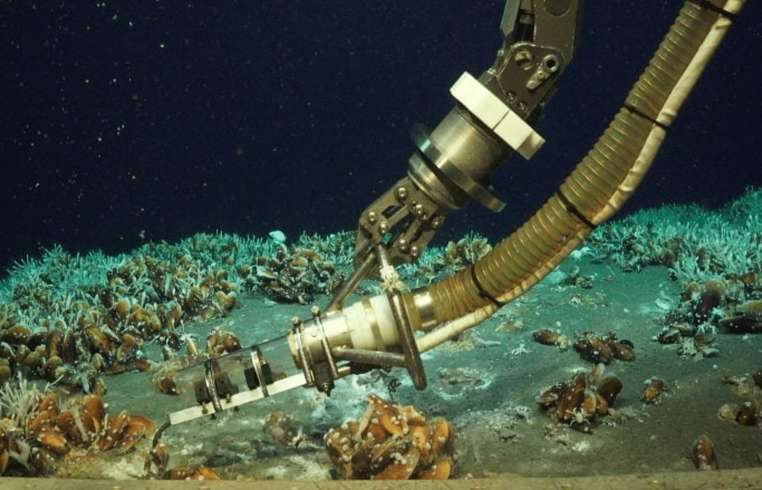
News - Scientists Uncover Mysterious Deep-Sea Vents Off Papua New Guinea, Full of Hidden Treasures! - Indian Defence Review
Business Strategy
Scientists Uncover Mysterious Deep-Sea Vents Off Papua New Guinea, Full of Hidden Treasures! - Indian Defence Review

Scientists have uncovered a breathtaking anomaly deep beneath the ocean, off the coast of Papua New Guinea, revealing an extraordinary geological and biological discovery. At a depth of 4,250 feet, researchers stumbled upon a unique deep-sea vent field where hot hydrothermal fluids and cold methane-rich gases emerge in close proximity. Published in the journal Scientific Reports, this discovery offers new insights into the mysteries of Earth’s underwater ecosystems and the potential threats they face. The Unexpected Discovery of Hybrid Vents In the depths of the western Pacific Ocean, scientists were stunned to find a combination of hot hydrothermal vents and methane-rich gas seeps, an occurrence that had never been observed before. “We essentially have a hot vent bubbling right next to a cool gas seep – a combination that has never been described before,” explains Dr. Philipp Brandl, marine geologist at the GEOMAR Helmholtz Centre for Ocean Research Kiel. The discovery took place near the island of Lihir, Papua New Guinea, at a location known as Conical Seamount. This peculiar underwater environment is the result of unique geological conditions, where magma beneath the seafloor warms the sediments, producing both methane gas and hot mineral-rich fluids simultaneously. Dr. Brandl and his team were well aware of the region’s volcanic activity, but the dual venting system came as a complete surprise. “No one really expected to find a hydrothermal field here, let alone one that is so exceptional,” he says. Previous research cruises had hinted at minor hydrothermal activity, but the extent of this discovery remained hidden until a more specialized exploration took place. It was only through the use of the ROV Kiel 6000, a remotely operated vehicle, that the true scale of this unique site was revealed. “It was a real surprise,” Brandl adds, particularly since several research expeditions had passed over the area without uncovering the anomaly. The discovery has now opened up a whole new realm of underwater exploration and research possibilities. A Hybrid Ecosystem Like No Other The most intriguing aspect of this find is not just the geological anomaly but the diverse life it supports. The combination of hot and cold venting creates a hybrid ecosystem that has never been seen before. “In places, you couldn’t see a single patch of rock because everything is so densely populated,” says Brandl, describing the vibrant life surrounding the vents. Deep-sea mussels, shrimp, and striking purple sea cucumbers thrive in this harsh yet life-sustaining environment. These creatures have adapted to survive in conditions that are rarely encountered on Earth, making the discovery an unprecedented glimpse into the resilience of marine life. The region is believed to host species that may have never been documented before. “We are confident that some of the species there have not yet been described. However, a dedicated expedition would be needed to fully study this unique habitat,” Brandl notes. The ecosystem, teeming with life, demonstrates just how little we know about the diversity of life that can flourish in extreme environments. With such a wealth of unknown species likely residing there, the discovery opens up possibilities for groundbreaking research in marine biology and the study of extremophiles. The Geological Significance of the Karambusel Field The location of the Karambusel hydrothermal field is just as fascinating as its biological wonders. Situated along the side of Conical Seamount, the field sits atop thick layers of organic material-laden sediments. The rising magma heats these layers, resulting in both the methane gas and hot mineral-rich fluids that are vented simultaneously. The interaction between these two geological processes creates a unique set of chemical conditions that influence both the surrounding ecosystem and the geology of the region. As hot fluids rise through the seafloor, they deposit precious metals like gold and silver, as well as toxic elements like arsenic and mercury, creating a complex and dynamic geological landscape. This rare combination of geological features has far-reaching implications for the study of Earth’s deep-sea environments. The unusual chemistry and mineral deposits found in the Karambusel field may provide new insights into the processes that shape the planet’s oceans. It is also a valuable natural laboratory for studying how different geological forces interact with one another, offering scientists the opportunity to examine Earth’s internal workings in unprecedented detail. The Growing Threats from Human Activity While the discovery of the Karambusel field is a remarkable scientific achievement, it comes with an urgent warning. The very ecosystem that makes this site so unique is under significant threat from human activities. Mining operations, such as the Ladolam gold mine located on Lihir Island, discharge waste and residues into the surrounding sea, potentially damaging the delicate balance of this newly discovered habitat. In addition, exploration licenses for seabed minerals and hydrocarbons are already in place, which could further jeopardize the future of this fragile environment. Philipp Brandl stresses the need for protection of the Karambusel field before economic interests destroy it. “We have discovered an unexpected treasure trove of biodiversity in the Karambusel field that needs to be protected before economic interests destroy it,” he warns. The region’s unique biodiversity, which is unlike any other deep-sea habitat, must be preserved through targeted marine spatial planning and strict environmental protections to ensure that this extraordinary discovery does not vanish under the pressures of commercial exploitation. The Need for Further Exploration and Conservation The discovery of the Karambusel field has opened up new avenues for scientific exploration and conservation. There is a pressing need for dedicated research expeditions to fully understand the ecosystem and the species that inhabit it. “A dedicated expedition would be needed to fully study this unique habitat,” says Brandl. Given the wealth of unknown species likely residing in the field, scientists are eager to learn more about this unusual ecosystem and the ways in which its inhabitants have adapted to survive in such extreme conditions. Moreover, the geological and biological significance of the site calls for urgent conservation efforts. The field’s vulnerability to human activity, such as mining and seabed exploration, underscores the importance of protecting this fragile habitat before it is irreversibly damaged. As Brandl emphasizes, “We have discovered an unexpected treasure trove of biodiversity in the Karambusel field that needs to be protected.” With the findings published in Scientific Reports, the global scientific community is now acutely aware of the importance of preserving this remarkable deep-sea environment.






